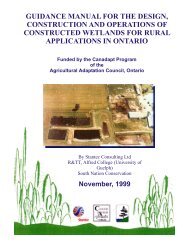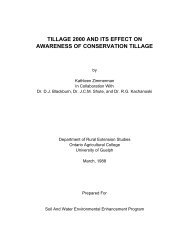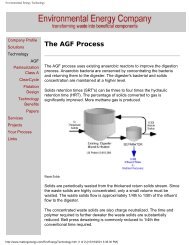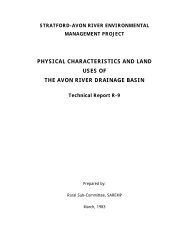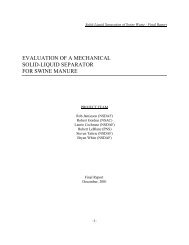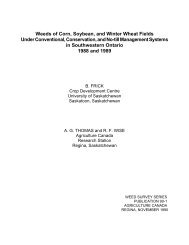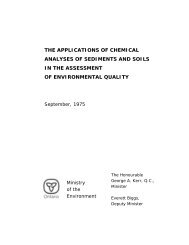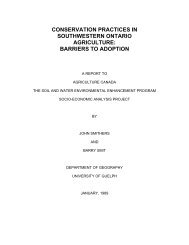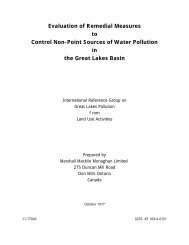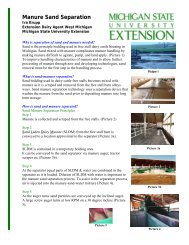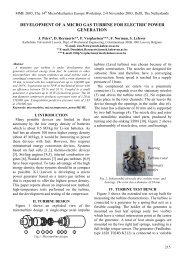Environmental Aspects of Phosphate and Potash Mining United ...
Environmental Aspects of Phosphate and Potash Mining United ...
Environmental Aspects of Phosphate and Potash Mining United ...
You also want an ePaper? Increase the reach of your titles
YUMPU automatically turns print PDFs into web optimized ePapers that Google loves.
Beneficiation<br />
The <strong>Environmental</strong> Approach <strong>of</strong> the <strong>Phosphate</strong> Rock <strong>and</strong> <strong>Potash</strong> <strong>Mining</strong> Industry<br />
24<br />
Water Contamination<br />
Water contamination may occur through spillage <strong>of</strong><br />
ore slurries or brines from pipelines <strong>and</strong> the mobilization<br />
<strong>of</strong> fines by rain run-<strong>of</strong>f from roads or stockpiles.<br />
The effects <strong>of</strong> slurry pipeline spillages are reduced<br />
through the use <strong>of</strong> monitoring <strong>and</strong> containment techniques.<br />
Automated monitoring systems allow<br />
management to be notified in a timely manner in the<br />
event <strong>of</strong> a failure. Earth walls <strong>and</strong> double-lined pipes<br />
contain <strong>and</strong> reduce the extent <strong>of</strong> the spill until remedial<br />
action can be taken.Soil <strong>and</strong> groundwater<br />
contamination may also result from the spillage <strong>of</strong><br />
brines.<br />
Fines generated from heavy vehicle traffic on unsealed<br />
roadways <strong>and</strong> from stockpile areas may contaminate<br />
run-<strong>of</strong>f water. The fines can be contained by the use <strong>of</strong><br />
techniques like silt traps <strong>and</strong> sediment retention dams.<br />
Methods are discussed further in Section 3.3,<br />
“Excavation”.<br />
Noise<br />
Heavy vehicles <strong>and</strong> equipment use can generate significant<br />
noise, sometimes around the clock, affecting the<br />
well-being <strong>of</strong> neighboring communities. The impact is<br />
reduced by the careful location <strong>of</strong> roads, use <strong>of</strong> noise<br />
barriers or buffer zones, sequencing <strong>of</strong> mining operations<br />
<strong>and</strong> restricting the operating hours <strong>of</strong> the<br />
equipment.<br />
Slurry pipelines address this concern, as they produce<br />
little noise.<br />
3.5 Beneficiation <strong>and</strong> Concentration<br />
Beneficiation <strong>and</strong> concentration may adversely affect<br />
the environment by:<br />
The generation <strong>of</strong> wastes such as s<strong>and</strong>, magnetite<br />
<strong>and</strong> salt tailings, clay fines <strong>and</strong> brines;<br />
The consumption <strong>and</strong> contamination <strong>of</strong> large volumes<br />
<strong>of</strong> fresh water during processing with fines,<br />
chemical reagents, <strong>and</strong> brines;<br />
The emission <strong>of</strong> dust from processing operations<br />
such as crushing <strong>and</strong> drying;<br />
The emission <strong>of</strong> exhaust particulates <strong>and</strong> gases<br />
during the generation <strong>of</strong> electrical power <strong>and</strong> the<br />
drying <strong>of</strong> product.<br />
Other potential impacts include noise <strong>and</strong> vibration<br />
produced by equipment such as rock breakers, crushers<br />
<strong>and</strong> grinding mills.<br />
Figure 3.5.1<br />
Potential environmental effects : beneficiation<br />
Size reduction<br />
(crushing, grinding,<br />
screens, cyclones)<br />
Separation,<br />
concentration <strong>and</strong><br />
contaminant removal<br />
Drying, compaction,<br />
granulation, etc...<br />
Waste Generation<br />
Waste generation<br />
Water consumption<br />
Water contamination<br />
Air emissions<br />
Noise <strong>and</strong> vibration<br />
Resource maximization<br />
Product transported<br />
to further processing,<br />
distribution <strong>and</strong> use<br />
The large volumes <strong>of</strong> waste generated during beneficiation<br />
<strong>of</strong> phosphate rock <strong>and</strong> potash may potentially<br />
cause adverse environmental effects. The volume <strong>and</strong><br />
type <strong>of</strong> wastes will depend on the ore characteristics<br />
(ore grade, constituent minerals, <strong>and</strong> contaminants),<br />
in addition to the specific beneficiation process<br />
employed.<br />
A variety <strong>of</strong> wastes is generated from the beneficiation<br />
<strong>of</strong> phosphate rock, <strong>and</strong> may include:<br />
Oversize low-grade rock from screening;<br />
Coarse tailings composed <strong>of</strong> s<strong>and</strong>;<br />
Fine tailings composed <strong>of</strong> clays <strong>and</strong> similar size<br />
materials;<br />
Process water contaminated with fines <strong>and</strong> process<br />
reagents.<br />
In some instances, magnetite tailings have also be generated.<br />
The beneficiation <strong>of</strong> potash produces wastes such as:<br />
Tailings consisting largely <strong>of</strong> impure salt (NaCl)<br />
with smaller amounts <strong>of</strong> other minerals such as<br />
anhydrite;<br />
Slimes consisting <strong>of</strong> insoluble fines such as clay<br />
<strong>and</strong> dolomite;<br />
Brines containing salt or magnesium chloride.<br />
In most countries, wastes are disposed <strong>of</strong> to specially<br />
engineered impoundments such as dams <strong>and</strong> ponds<br />
or released in a controlled manner to the environment.<br />
Disposal methods are discussed in detail in<br />
Section 3.7 “Waste Management <strong>and</strong> Disposal”.



